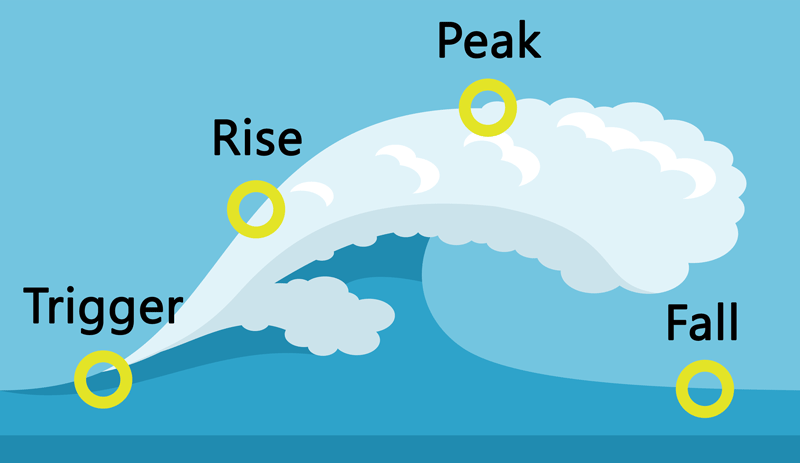Urge surfing and emotion surfing are twin techniques, based on the same psychological insights.
Unwanted urges and emotions can conspire to keep us in mental loops:
- Urges and cravings make us frustrated and miserable
- To relieve frustration and misery, we experience urges and cravings
And none of us are immune from these experiences. But we can learn to follow a simple set of thinking-steps that allow these feelings to move along quietly.

The basic steps
Acceptance
We acknowledge that we’re having this urge, feeling or thought. The worst it can do is make us feel or think it. Maybe it’s due to some habit or conditioning – it happens.
Noticing
What does this really feel like? Can we feel it in the body? Can we describe the feeling? Are we telling ourselves any stories about what this means?
Breathing
We use our breath to feel more grounded. No need to change anything, just noticing the rise and fall of our breathing that goes unnoticed most of the time.
Riding the wave
We envisage a wave, rising up, cresting and falling away. Some people like to picture a wave, or hear it, or even smell the sea air. Or we might feel the sensation, briefly passing through us.
Staying on top of the experience
Using our breath as our surfboard, we can feel more present and observing. Whether it’s an urge or an emotion, we give the feeling all the time it needs to pass. We can feel assured that it will, and that we can ride out any waves that follow.
Example: the urge to check my phone (again)
Here’s a quick example of stepping through the urge surfing technique.
Accepting that I’m experiencing an urge, large or small. So I want to grab my phone and check for updates right now. But I also want to finish this work assignment / mortgage application / college essay.
I’m going to stay with this feeling and just see what happens next.
I’ll notice what this urge actually feels like – where or how do I feel it in my body? hmm it feels like a tension in my neck, and a kind of agitation going through me.
How’s my mood in this moment? A bit frustrated… feeling restless yet stuck. What am I doing again?
I’ll breathe into the feeling. Just noticing the rise and fall of my breath, no need to change anything. I might direct my breath towards the feeling in my body for a moment or two.
As I notice and breathe, I might envisage a wave swelling, rising… and then cresting and falling away. Maybe I hear it, maybe I can feel it pass. Other waves may follow, and that’s just fine.
I can take as long as I need with this. I’m staying on top of the experience. The need to check my phone feels different already, and I feel more in control.
Emotions, feelings, thoughts, urges – let’s be clear on the terminology here
At base level, emotions are the chemical changes in our brains and bodies in response to things in our environment. Emotions happen subconsciously; they are the raw data of our experience.
Then we experience feelings, and they bubble up into our awareness. Feelings are our interpretations of our experience: “I feel cold in my stomach” or “I feel cold towards this other person”. See how feelings are influenced by our beliefs and fears too.
Thoughts are the meanings, stories and strategies that we respond with. “I shouldn’t be this way” or “I need to do something about this”. Our thinking brain is an incredible resource, but it causes much of our misery too.
From this feedback loop of emotion, feeling and thought, urges are our calls to action – helpful or not.
Urge: a strong desire or impulse – Oxford English dictionary
Urge surfing and emotion surfing are twin techniques. Both help us to recognise, accept and exercise more choice in what our next move will be.
Interrupting unhelpful thoughts
Emotions happen to us – we have little control over what pops up in our awareness. And that’s a good thing. If we had to manually control our feelings all the time, we’d never get anything done.
But that doesn’t mean they can push us around.
Rumination, rabbit-holes, rage, looking out for the very worst and constantly berating ourselves. These are just some of the traits of anxiety, low mood and depression.
Addressing the root causes of these tendencies usually requires more than a simple mindfulness technique. We may need to adjust the stories we tell ourselves, process past trauma and develop a strategy to tackle the problems in our lives. All of this is the good work of therapy and personal development.
But emotion surfing can help us interrupt rumination and calm our emotions. It’s a tool for riding out the impulse to over-think and catastrophise.
And urge surfing helps us to notice and interrupt our habits with acceptance and calm.
When we allow feelings to pass, we have more capacity to explore ideas and take more positive action.